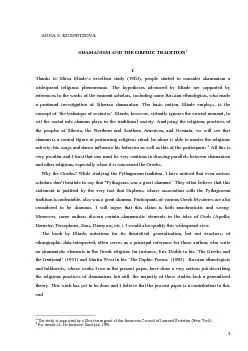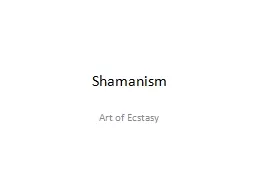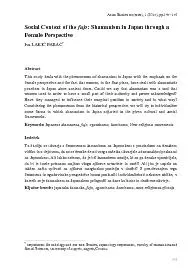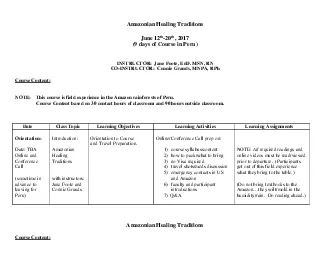PPT-Shamanism
Author : trish-goza | Published Date : 2017-01-24
Art of Ecstasy Shamanism is a range of traditional beliefs and practices that involve the ability to diagnose cure and sometimes cause human suffering by traversing
Presentation Embed Code
Download Presentation
Download Presentation The PPT/PDF document "Shamanism" is the property of its rightful owner. Permission is granted to download and print the materials on this website for personal, non-commercial use only, and to display it on your personal computer provided you do not modify the materials and that you retain all copyright notices contained in the materials. By downloading content from our website, you accept the terms of this agreement.
Shamanism: Transcript
Art of Ecstasy Shamanism is a range of traditional beliefs and practices that involve the ability to diagnose cure and sometimes cause human suffering by traversing the axis mundi and forming a special relationship with or gaining control over spirits Shamans have been credited with the ability to control the weather divination the interpretation of dreams astral projection and traveling to upper and lower worlds Shamanistic traditions have existed throughout the world since prehistoric times. Animism rather than Shamanism new approaches to what shamans do for other animists In Schmidt Bettina and Huskinson Lucy eds Spirit Possession and Trance New Interdisciplinary Perspectives Continuum Advances in Religious Studies 7 London Continuum Angela Thompson Smith, Ph.D.. Shamanism is commonly accepted in many cultures of the world.. Some of the topics of this Introduction are:. What is shamanism?. How does one become a shaman?. Shamanic traditions and culture. The study is supported by a Short-term grant of the American Council of Learned Societies (New York). For details cf., for instance: Smolyak, 1991. 1 Martin West believes that Orpheus entered the 47 International Journal of Transpersonal Studies(2), 2013, pp. 47-62he concept of the shaman has spread across the world in recent decades, manifesting, in Langdon & Baer, 1992; Whitehead, 2002), fe Art of Ecstasy. Shamanism is a range of traditional beliefs and practices that involve the ability to diagnose, cure, and sometimes cause human suffering by traversing the axis mundi and forming a special relationship with, or gaining control over, spirits. Shamans have been credited with the ability to control the weather, divination, the interpretation of dreams, astral projection, and traveling to upper and lower worlds. Shamanistic traditions have existed throughout the world since prehistoric times. ARTISTS AS . SHAMANS: . A CRITICAL & HISTORICAL OVERVIEW. DENITA BENYSHEK. SAYBROOK UNIVERSITY . SAN FRANCISCO, CA. UNIVERSITY OF PHOENIX. WESTERN WASHINGTON. INTERNATIONAL. SOCIETY FOR. SHAMANISTIC. By:. Abril. . Avendano. , Arianna Beltran,. April Orozco,. . Amanda Quintero,. . Jayleen. Rodriguez. Period 2. Introducing Shamanism. Practice not really a religion . One of the world’s most complex religions. Tibetan Buddhism. It borrows from many faiths.. It is practiced at many levels.. It evolves.. It has no definitive canon of scriptures. . It has many branches and spokespersons. . – 170 145 Social C ontext of the f ujo : Shamanism in Japan through a F emale P erspective Iva LAKIĆ PARAĆ * Abstract T his study deal s with the phenomenon of shamanism in Japan with the emp Course ContentDateLearning ObjectivesLearning ActivitiesLearning AssignmentsOrientationDate TBAOnline and Conference Call sometime in advanceleaving forPeruIntroductionAmazonian Healing TraditionsOrie Roger Walah 37 ary these criticisms and Rothberg 1986 Rothberg map and terms have varied somewhat one publi- 1977 1981 1983a 1983b 1997 Wilber eta consistently points major classes into which transper TODAYGRADES 11-12AUTHOR Jennifer Burns SUBJECT Religion TIME REQUIRED One 90-minute class period OBJECTIVESTo understand the basic tenets of Korean Shamanism and the kut To explain why Korean Shamanis Working with the image of the Indian shaman as Wild Man, Taussig reveals not the magic of the shaman but that of the politicizing fictions creating the effect of the real.This extraordinary book . . . will encourage ever more critical and creative explorations.—Fernando Coronil, [I]American Journal of Sociology[/I]Taussig has brought a formidable collection of data from arcane literary, journalistic, and biographical sources to bear on . . . questions of evil, torture, and politically institutionalized hatred and terror. His intent is laudable, and much of the book is brilliant, both in its discovery of how particular people perpetrated evil and others interpreted it.—Stehen G. Bunker, Social Science Quarterly The foundational work on shamanism now available as a Princeton Classics paperbackShamanism is an essential work on the study of this mysterious and fascinating phenomenon. The founder of the modern study of the history of religion, Mircea Eliade surveys the tradition through two and a half millennia of human history, moving from the shamanic traditions of Siberia and Central Asia--where shamanism was first observed--to North and South America, Indonesia, Tibet, China, and beyond. In this authoritative survey, Eliade illuminates the magico-religious life of societies that give primacy of place to the figure of the shaman--at once magician and medicine man, healer and miracle-doer, priest, mystic, and poet. Synthesizing the approaches of psychology, sociology, and ethnology, Shamanism remains the reference book of choice for those interested in this practice.
Download Document
Here is the link to download the presentation.
"Shamanism"The content belongs to its owner. You may download and print it for personal use, without modification, and keep all copyright notices. By downloading, you agree to these terms.
Related Documents














